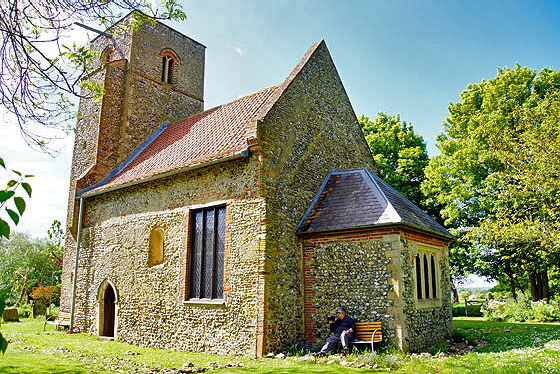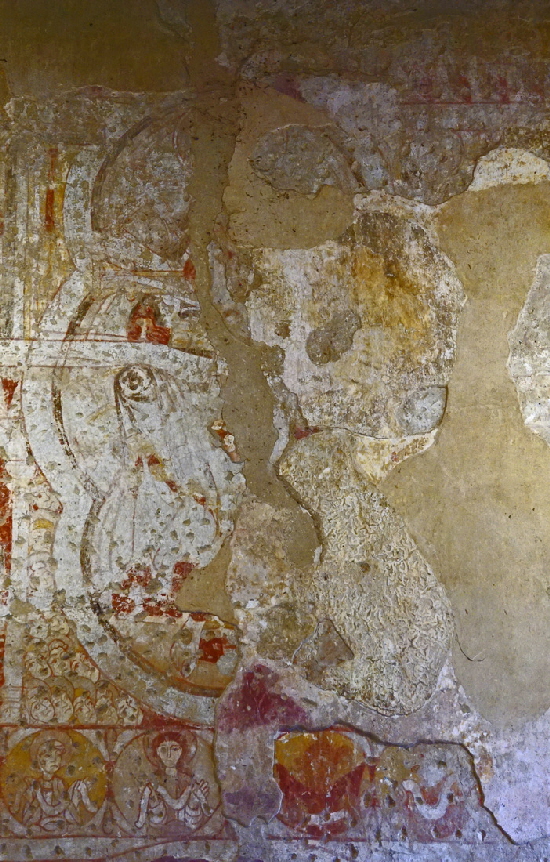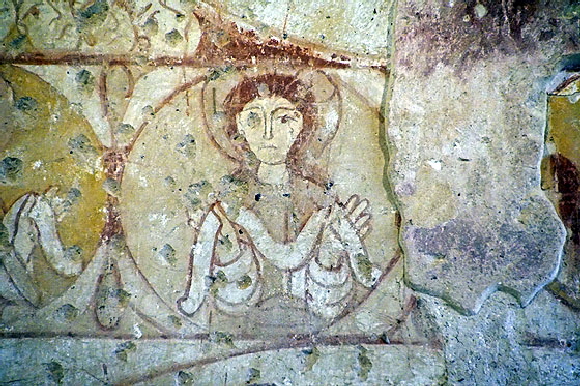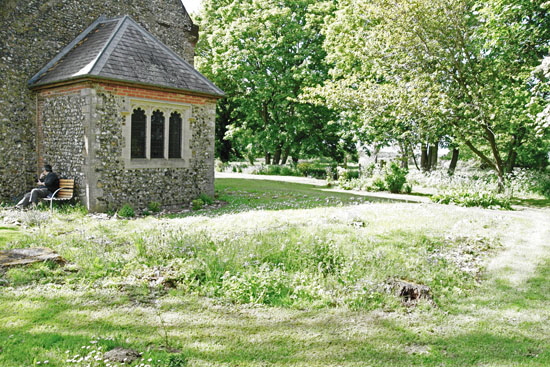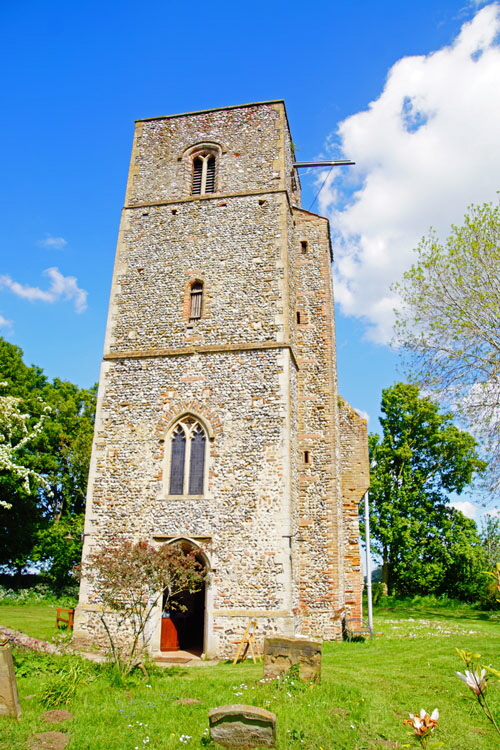|
|
|||||||||||||||||||||||||||||
|
ramble went there in 1992. Her husband, Bob Davey, Churchwarden at nearby North Pickenham, investigated and found it was being used for satanic rituals! Bob decided o make it his project to restore the church. He sold up his antiques business and its stock and sank it into the restoration saying “it had to be done”. In 1995 fragments of wall painting were spotted. Not until 2006 were they restored to the condition we see today. Roger Rosewell who wrote the magisterial “Medieval Wall Paintings” (Boydell Press, 2008) sees them as the “the most extensive scheme of early paintings to have survived” and “despite some affinities with Anglo-Saxon traditions, the stylistic characteristics of the paintings are indicative of Norman or Romanesque art”. Those two statements beg an awful lot of questions in terms of dating but Rosewell does see them as predating the celebrated “Lewes School” paintings seen at Hardham and Clayton and Coombes in Sussex by a couple of decades or more. They are usually dated to about AD1100. I have to express surprise, mind you, if he feels the scheme at Houghton is more extensive than at Hardham. Surely not? The church itself is a curious-looking structure.. The chancel - the third version here - dates from 1760. I forgive myself for thinking that it dates from the modern restoration. I am racking my brains of anything similar. Two larger and earlier chancels are marked out east of the church and their rooflines are also visible on the east end of the nave (see picture above). The first was probably apsidal; the second was quite long. So chronologically, the earliest church was probably a simple nave and apsidal chancel with a round west tower. A south aisle was added at some point, but only its outline remains. We know it was not part of the original building because of the survival of a pre-Conquest style nave window on that side. It is probably that it collapsed in the early fourteenth century because of the design of the replacement south door; and this is when the Decorated style rectangular west tower replaced the round one and the apsidal chancel was subsumed by a longer, rectangular one with a higher roofline. And then the chancel got replaced by the incongruously short one of 1760. Anyway, the paintings are what will bring you here, not the architecture, so let’s talk a little about that. Rosewell pronounces Houghton as possessing the first doom (or “judgement”) painting in England and uses it as an exemplar to debunk the notion that such imagery was provoked by the death cult that emerged after the Great Plague of 1348. It also has the oldest but almost indistinguishable representation of Noah’s Ark. Most curious is a series of roundels depicting women seemingly holding snakes! Much is far from clear, not least because there were two subsequent layers of painting: a decorative layer of the fourteenth century and the mandatory and extremely tiresome post-Reformation layer of scriptural texts. It is always very difficult to do justice to mediaeval wall paintings on a website. The main reason is that photographs inevitably focus on individual elements whereas the real impact is experienced by seeing the whole. This is a place of wonder and something of a miraculous survival. Bob Davey received an MBE for his work . I am sure he and his family were bathed in justifiable pride. Frankly, I think he deserved more than that which is awarded customarily to Olympic Games bronze medal winners and minor “celebrities” . |
 |
|||||
|
The interior of the church looking east. The painting scheme has been adapted to the unmoulded chancel arch so we must presume it is part of the original structure and either predates or is contemporary with the paintings themselves. The eighteenth century chancel beyond is conspicuously undersized. I do not know the date of the two large niches either side of the chancel arch. They have been bricked in which implies that they were originally arches through to the chancel in the Anglo-Saxon custom such as is seen at Brixworth in Northamptonshire. Above the arch is a triple mandorla with God at its centre, Jesus in his lap and a haloed dove representing the Holy Spirit. |
|||||
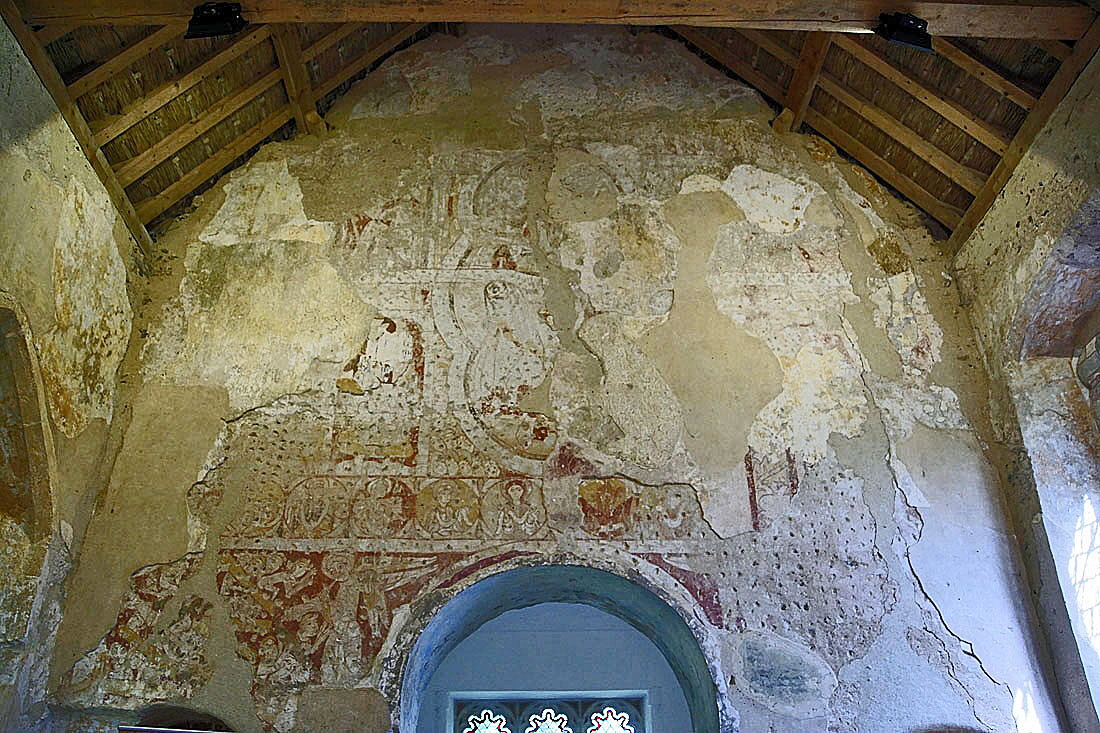 |
|||||
|
At seven o'clock from the mandorla you can see the awestruck - and presumably mightily relieved - faces of the “saved”. Below them is the series of roundels showing women holding what may be a snake(s) or, as the Church Guide speculates, scrolls (I don’t think so) or garments for the resurrected? To the left of the arch is an angel blowing the last trump for the resurrection of the dead as they scramble from their graves and head for the showers. |
|
|
||||||||||||||||||||||||||||
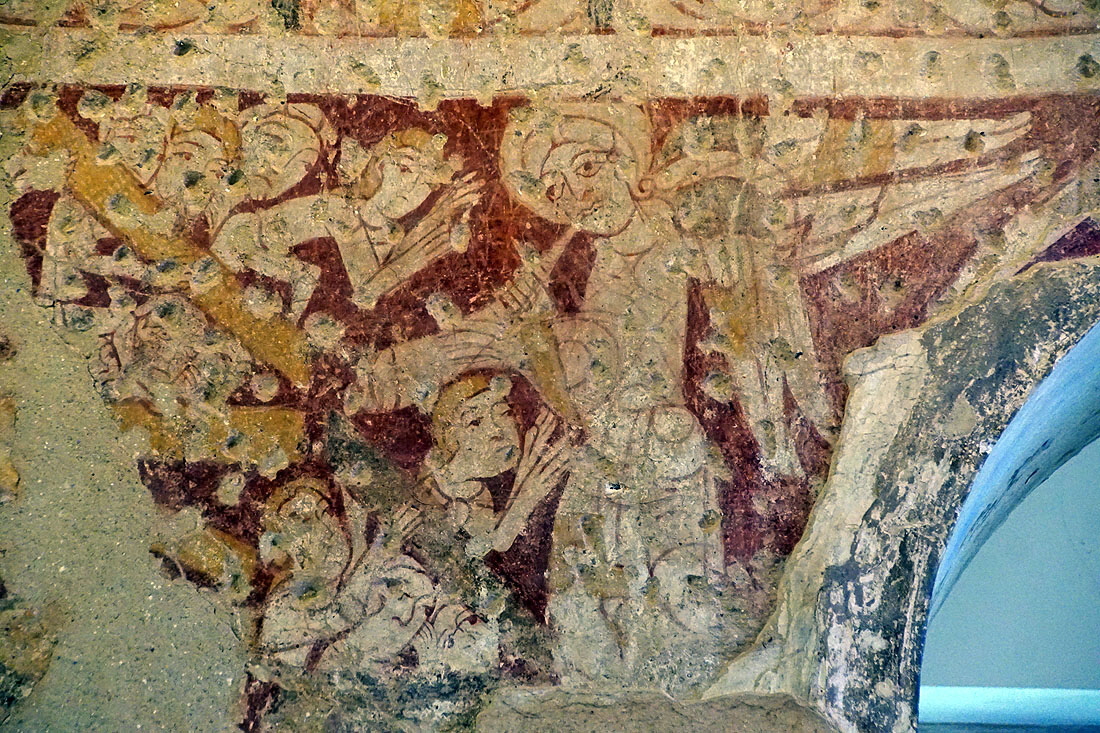 |
|
The angel blows the last trump. To his left, the dead emerge blinking and apprehensive from their graves into the light. The Church Guide is very informative about the actual paint. They say that cinnabar found in volcanic rocks was used for the red pigment and that this was an expensive import from probably Italy or Spain and that with Lewes it was the earliest use in this country. Houghton is itself the site of the earliest use of red lead and green earth in this country. |
|||||
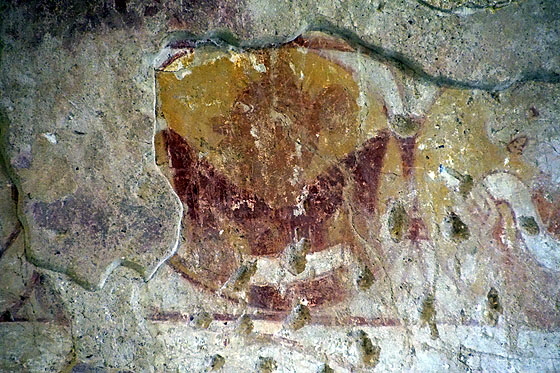 |
|||||
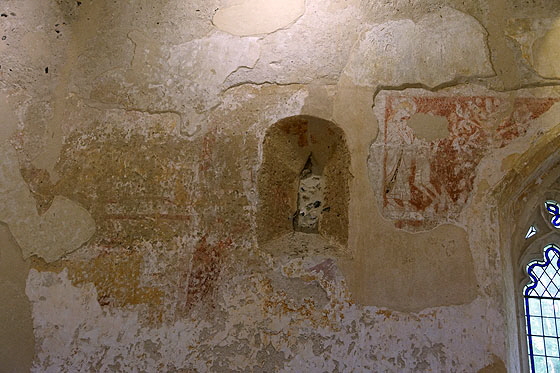 |
|||||
|
Left: Below the mandorla and to the right is Satan. You need to be looking at the yellow area. Once you have spotted them eye (white) you realise his head is in profile looking to the left and he becomes quite easy to discern. Right: The north wall and its pre-Conquest double splayed window. To the right is a scene of the Creation of Eve - see picture below. |
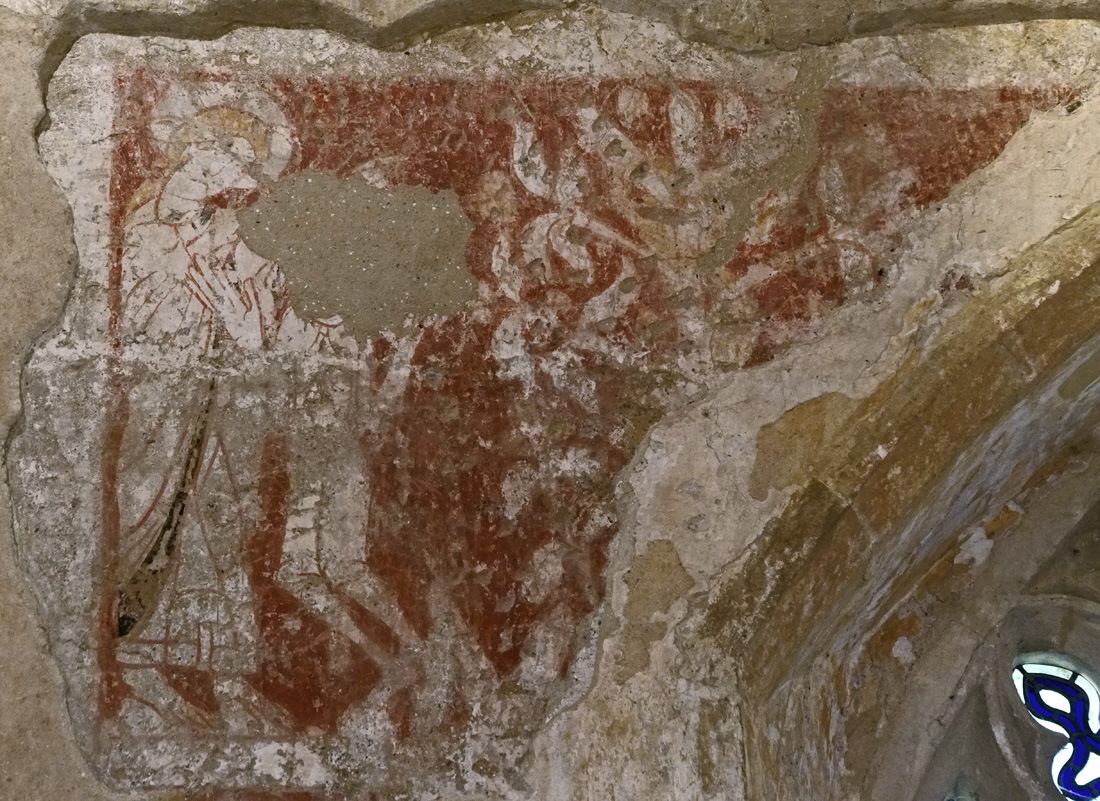 |
||||||
|
On the north wall are the remains of the Creation of Eve. The Tree of Life is to the right entwined (so the Guide Book says) by a serpent that you cannot see with the naked eye! Eve whose face has been lost is holding up her hands. God is on the left. Adam is resting against the tree, having relinquished a rib, poor chap. |
||||||
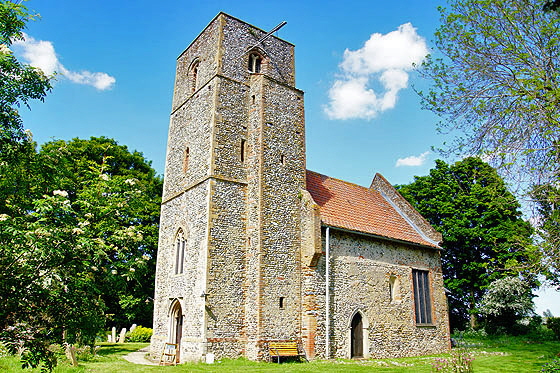 |
||||||
 |
||||||
|
Left: The Decorated style west tower looks much too big for the church. That, of course, is the consequence of the severe shortening of the chancel in the eighteenth century. It is quite an impressive structure although we must mourn the loss of the supposed earlier round tower. The rectangular window looks like it came from the catalogue of Everest Double Glazing but was installed in 1830 so it couldn’t have done. To its left is the forlorn and filled-in original pre-Conquest window. Right The north wall. The Gothic window is quite a pretty example of Decorated style curvilinear tracery. To its right is the outline of the filled-in pre-Conquest window surrounded by scavenged Roman tiles. It is known that there was a Roman villa nearby. You can also see a couple of surviving pre-Conquest “long and short” quoins. |
|
|
||||||||||||||||||||||||||||||||||||||||
|
This page is dedicated to my irreplaceable church-visiting “buddy” Bonnie Herrick, born and bred in Cleveland, Ohio and who, after more than forty years in this country nursing the rich, famous, crippled and insane has an appreciation of and irrepressible enthusiasm for England’s historical heritage that puts most of us to shame. On 29 May 2021 we made our first church visit together here at Houghton-on-the-Hill and later encountered the mysterious Buckden Triangle which cars have entered, never to re-emerge. A place where satnavs do not function but where lasting friendships may be forged. Here’s to you, Mrs T. May the road go on forever. |
 |
|
|
|
|
|
